


The revolutions which broke out
across Europe in 1848 were occasioned by
the harsh economic conditions of the time, but, like the rebellions
of 1830 and 1831 (W4),
they also provided a further chance to overthrow the reactionary
regimes on the continent. They met with limited success. In France,
a rebellion in Paris quickly spread, and brought about the departure
of King Louis Philippe, a constitutional monarch who, over the
years, had amassed an unacceptable amount of personal authority. But
the revolutionaries soon began quarrelling amongst themselves, and
eventually Louis Napoleon was elected to the throne. By 1852,
he had achieved supreme authority as Emperor of the French. In Italy too, where there were uprisings in
Venice, Milan and Rome, and the king of Sardinia-
THE REVOLUTIONS OF 1848 (Va)
Acknowledgements
Map (Europe):
licensed under Creative Commons –
commons.wikimedia.org/wiki/File:Map 1848. Paris:
by the French painter Horace Vernet (1789-
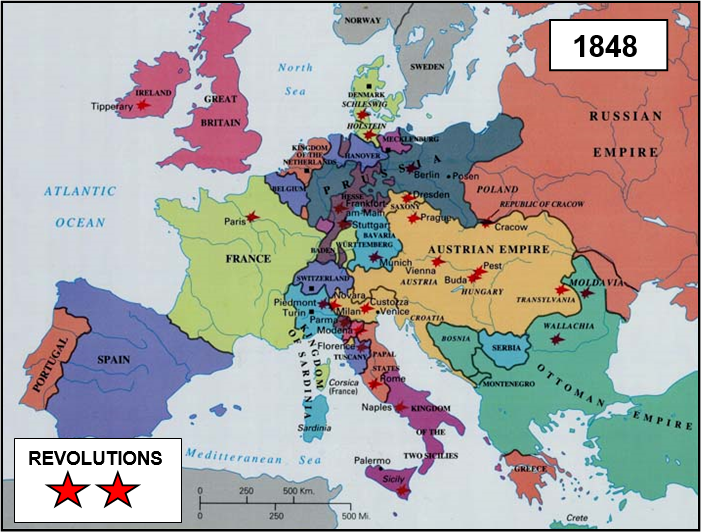 xxxxxThe rapid series of revolutions
which broke out across Europe in 1848 was due in large part to
the harsh economic conditions
prevailing at that time, made worse by a serious shortage of food
following three years of crop failure. But there was, too, as in 1830 and 1831
(W4), further
resistance against the reactionary regimes imposed by the Congress
of Vienna at the end of the Napoleonic Wars in 1815. Leaders like
the Austrian Prince von Metternich and the influential Russian
Tsar Alexander I were anxious to turn back the political clock in
order to impose order and stability throughout the continent. They
were opposed to liberal ideas and
self-
xxxxxThe rapid series of revolutions
which broke out across Europe in 1848 was due in large part to
the harsh economic conditions
prevailing at that time, made worse by a serious shortage of food
following three years of crop failure. But there was, too, as in 1830 and 1831
(W4), further
resistance against the reactionary regimes imposed by the Congress
of Vienna at the end of the Napoleonic Wars in 1815. Leaders like
the Austrian Prince von Metternich and the influential Russian
Tsar Alexander I were anxious to turn back the political clock in
order to impose order and stability throughout the continent. They
were opposed to liberal ideas and
self-
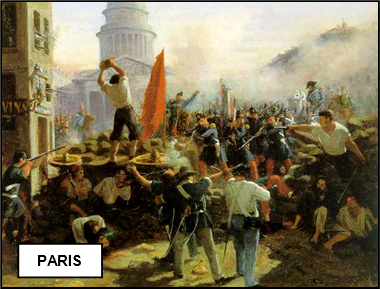 xxxxxIn France,
as we have seen, the last of the Bourbons, in the person of
Charles X, was toppled from power in 1830
(W4), and replaced by the more liberal-
xxxxxIn France,
as we have seen, the last of the Bourbons, in the person of
Charles X, was toppled from power in 1830
(W4), and replaced by the more liberal-
xxxxxHis departure brought about a provisional
government determined to give power to the people -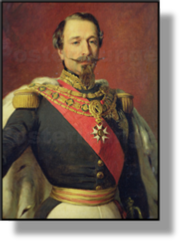 uprising
was ruthlessly crushed by the use of artillery in what came to be
known as the “June Days”. In December a new government -
uprising
was ruthlessly crushed by the use of artillery in what came to be
known as the “June Days”. In December a new government -
xxxxxInxItaly,
the Risorgimento,
the “revival movement” aimed at overthrowing Austrian control and
bringing about Italian unity, had long been at work, led by the Carbonari and a nationalist group known as Young Italy (Gionvane
Italia), founded by the revolutionary leader Giuseppe Mazzini (1805-
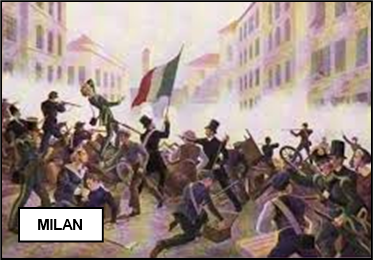 xxxxxBut whilst local rulers were prepared to go along
with the tide, the Austrians were determined to regain lost
ground. Come the summer, they went on the offensive, eventually
crushing the infant republics set up in Venice, Milan and Tuscany.
CharleszAlbert gained some early
victories over the Austrians, but he was roundly defeated at the Battles of Custoza and Milan in July 1848. Hexagreed to an armistice the following month, but then
went on the offensive again and was routed at the Battle
of Novara in March 1849. He was then
forced to abdicate in favour of his son Victor Emmanuel II, and
take himself off to Portugal. By this time, however, a democratic
republic had been established in Rome, defended by the
revolutionary leader Giuseppe Mazzini. Thexpope,
Pius IX, having already fled to Gaeta in the kingdom of Naples,
appealed for help, and the French sent an army to restore the
papacy. It struggled against the forces led by the Italian patriot
Giuseppe Garibaldi, and was well defeated at the Battle
of Velletri in May, but it eventually
captured Rome, and the Pope was able to return to his capital city
in April 1850. Meanwhile, Garibaldi escaped to fight another day.
xxxxxBut whilst local rulers were prepared to go along
with the tide, the Austrians were determined to regain lost
ground. Come the summer, they went on the offensive, eventually
crushing the infant republics set up in Venice, Milan and Tuscany.
CharleszAlbert gained some early
victories over the Austrians, but he was roundly defeated at the Battles of Custoza and Milan in July 1848. Hexagreed to an armistice the following month, but then
went on the offensive again and was routed at the Battle
of Novara in March 1849. He was then
forced to abdicate in favour of his son Victor Emmanuel II, and
take himself off to Portugal. By this time, however, a democratic
republic had been established in Rome, defended by the
revolutionary leader Giuseppe Mazzini. Thexpope,
Pius IX, having already fled to Gaeta in the kingdom of Naples,
appealed for help, and the French sent an army to restore the
papacy. It struggled against the forces led by the Italian patriot
Giuseppe Garibaldi, and was well defeated at the Battle
of Velletri in May, but it eventually
captured Rome, and the Pope was able to return to his capital city
in April 1850. Meanwhile, Garibaldi escaped to fight another day.
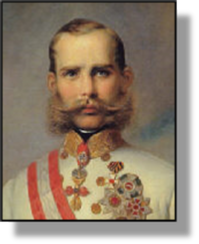 xxxxxBut Italy was not the only testing ground for the
troubled Austrian Empire.
In Vienna itself, popular demonstrations for reform -
xxxxxBut Italy was not the only testing ground for the
troubled Austrian Empire.
In Vienna itself, popular demonstrations for reform -
xxxxxIn the
meantime, however, two other nationalities within the Austrian
empire, taking advantage of the situation, rebelled against their
masters. Hungary
declared its independence in April, and in June a
Pan-
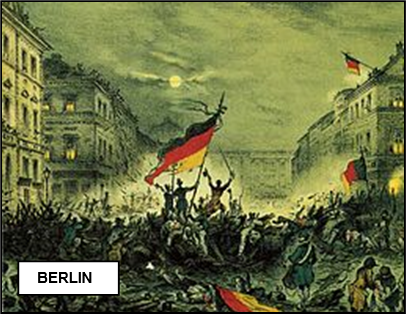 xxxxxGermany was also caught up
in this violent movement for change, but there it was centred
around the desire for national unity as well as national
independence. Afterxan uprising in
Berlin (illustrated), King Fredrick William agreed to a
constitutional assembly, and delegates representing all the states
met in Frankfurt in May 1848 to hammer out the making of a united
Germany. This so-
xxxxxGermany was also caught up
in this violent movement for change, but there it was centred
around the desire for national unity as well as national
independence. Afterxan uprising in
Berlin (illustrated), King Fredrick William agreed to a
constitutional assembly, and delegates representing all the states
met in Frankfurt in May 1848 to hammer out the making of a united
Germany. This so-
xxxxxElsewhere,
however, some reform was achieved. In Prussia, a move towards parliamentary government was made,
and in Switzerland
a federal union was formed -
xxxxxNone of the revolutions proved wholly successful, and most of them had been crushed by the early months of 1849. Nevertheless, a number brought about significant changes. In France, for example, the overthrow of Louis Philippe eventually brought to power Napoleon III, bent on military grandeur, whilst in Austria, Prince von Metternich was replaced as the opponent of reform by the new monarch, Franz Joseph. An event of particular importance was the suppression of the Hungarian revolution. This was achieved with the assistance of the Russian army but, as we shall see, in the Crimean War which broke out in 1853, the Austrians threatened to enter the war against their former ally. This put an end to the long understanding between the two reactionary powers, and weakened Austria’s standing in the struggle for Italian unification which broke out again in 1859.
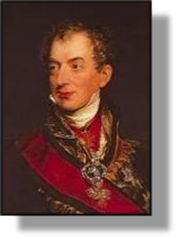
xxxxA casualty
of the revolution in Austria was the powerful politician Prince von Metternich (1773-
xxxxxMetternich
was born into an aristocratic family, and studied at the
universities of Strasbourg and Mainz. As a member of the
diplomatic corps, he served the Habsburgs as ambassador to Saxony,
Prussia and then to Napoleonic France in 1806, the year after his
country’s humiliating defeat at the Battles of Ulm and Austerlitz.
Three years later he was appointed minister of foreign affairs,
and during his first year in office he astutely arranged the
marriage between Marie Louise, the Austrian arch-
xxxxxAt the
Congress of Vienna which followed the final defeat of Napoleon in
1815, he attempted to establish a balance of power between the
major countries. He failed to bring Britain and, later, France,
into an alliance aimed at maintaining the old order in Europe, but
with the support of both these countries he held in check Prussian
and Russian demands for territory. And, at the same time, he 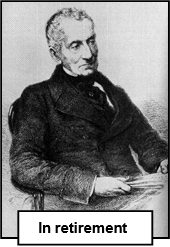 obtained
the support of both these east European powers in maintaining the
status quo across much of the continent. By means of the Holy
Alliance, a series of congresses -
obtained
the support of both these east European powers in maintaining the
status quo across much of the continent. By means of the Holy
Alliance, a series of congresses -
Including: France,
Italy, Sardinia-
The Austrian Empire, Hungary, Bohemia,
Germany, Prussia, Switzerland, Denmark
and Prince von Metternich

Va-


